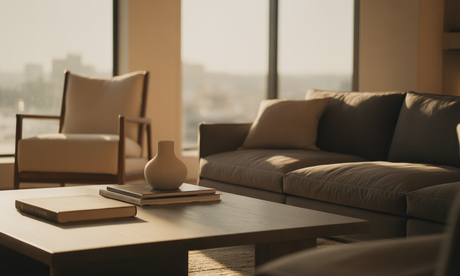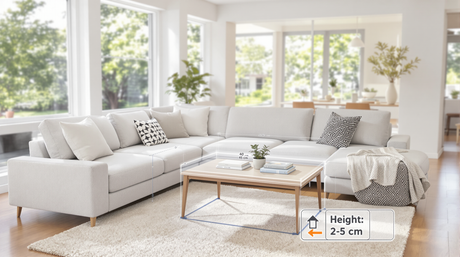
Recently, many of us have discovered a newfound need for a home office space that might not have been utilised to this extent. Whether you already have a home office, repurposed a room, or designated a workspace within a shared area, optimising this environment for productivity and serenity is essential. Here, we provide valuable tips to ensure your home office is a sanctuary for work and relaxation.
Table of Contents
The Importance of Separation
First and foremost, consider keeping your home office in a separate room if possible. Maintaining this physical divide between work and living spaces is a psychological strategy that helps you enter "work mode" at home. This separation can enhance your focus during work hours and facilitate the transition to personal and family time during non-working hours.
If a dedicated room is not an option, carve out a specific space within a room and commit to using it exclusively for work-related activities. This subtle separation from other domestic functions, such as dining or play areas, can have a similar psychological effect, aiding in maintaining a work-oriented mindset.
Essential Elements for Your Home Office
Now, let's delve into the essentials that will transform your home office into a productive and comfortable workspace.
1. A Dedicated Work Surface
Why it's important: A dedicated work surface, such as a desk or table, provides a structured area for your tasks. It helps you mentally separate work from leisure, enhancing focus and productivity.
2. Comfortable Seating
Why it's essential: Comfortable seating, preferably an ergonomic chair, supports your posture during long work hours, reducing the risk of discomfort and pain. It's essential for your physical well-being.
3. Adequate Storage
Why it's essential: Proper storage solutions, like shelves, drawers, or cabinets, keep your workspace organised and clutter-free. This ensures that essential documents and supplies are within easy reach.
4. Efficient Lighting
Why it's essential: Adequate lighting, both natural and task lighting, reduces eye strain and creates a conducive work environment. It's essential for maintaining focus and preventing fatigue.
5. Personalised Decor
Why it's essential: Personalised decor, including artwork, inspirational items, or plants, adds a touch of individuality to your workspace. It boosts motivation and creates a pleasant atmosphere.
6. Cable Management Solutions
Why it's essential: Effective cable management prevents cluttered appearance and tripping hazards. It ensures that your technology is seamlessly integrated into your workspace.
7. Technology Setup
Why it's important: A well-organised technology setup, including a computer, monitor, and peripherals, is vital for completing tasks efficiently in the digital age.
8. Office Supplies
Why it's crucial: Essential office supplies, such as pens, notepads, and stationery, contribute to a functional workspace, ensuring you have the tools you need at your fingertips.
9. Personal Comfort Items
Why it's essential: Personal comfort items like a cushion or footrest can enhance your comfort during extended work hours, reducing strain and fatigue.
10. A Clock or Time Management Tool
Why it's important: A clock or time management tool helps you stay on track with your work schedule, allowing you to manage your time effectively.
Incorporating these essential elements into your home office setup will help create a productive, comfortable, and personalised workspace that optimises your work-from-home experience.
The Clean and Clutter-Free Zone
A clutter-free and organised workspace is crucial for focusing on your work tasks. Distractions should be minimised, allowing you to concentrate on your job rather than your home to-do list. This is where the earlier separation principle proves its worth, as a clean and uncluttered workspace is easier to maintain when it's isolated from other household activities.
Adding Inspirational Elements
To boost your motivation and productivity, consider adding elements that inspire you. This can be a piece of artwork that resonates with you, a souvenir from your travels, a meaningful quote, or a picture of your family. Such items inject positivity into your workspace, making it a place where you feel motivated and empowered. Adding some real or faux greenery can also introduce a refreshing touch to the space.
Illuminating Your Workspace
Lighting is a vital aspect of any office setup. Natural light is ideal for boosting your mood and keeping you alert. If you have access to it, position your workspace near a window. However, task lighting is equally important, especially when you spend significant time in front of a screen. Combining various light sources allows you to adjust the lighting to suit the time of day and weather conditions.
Prioritising Comfort
When selecting furniture for your home office, ensure it prioritises your comfort. While office chairs are designed for long periods of sitting, not everyone has access to them at home. If using an alternative seat, focus on maintaining good posture and comfort. Take regular breaks to stretch, benefiting both your physical and mental well-being.
Making It Your Own
Most importantly, make your home office space reflect your unique needs and preferences. Consider what will help you concentrate and maintain peace of mind, as this will guide your design choices. Personalise your workspace to align with your work type and enjoy the convenience of a short daily commute.
Conclusion
Adapting your home office for optimal functionality and comfort during these times is ongoing. As you fine-tune your workspace, consider what works best for you and how it contributes to your productivity and well-being. Embrace the opportunity to create a space that seamlessly blends work and home life, enhancing your overall work experience.
FAQs
1. Can I mix and match different furniture styles?
Absolutely! Mixing styles can add a unique charm to the room while reflecting your child's personality.
2. How can I make the room feel more extensive with furniture?
Opt for multi-functional furniture like loft beds with built-in desks or storage drawers to maximise space.
3. What if my child's interests change over time?
Choose versatile furniture and incorporate changeable elements like wall decals and removable accessories.
4. How can I involve my child in choosing their furniture?
Involve them in the shopping process and let them express their preferences by selecting colours, themes, and certain furniture pieces.





